Leonid Frantsevich
RIGHTING KINEMATICS IN BEETLES (INSECTA: COLEOPTERA)
Arthropod Structure & Development 2004, 33: 221-235.
Abstract. Twenty modes of stereotyped righting motions
were observed in 116 representative species of Coleoptera. Methods included cine
and sterocine recording with further frame by frame analysis, stereogrammetry,
inverse kinematic reconstruction of joint angles, stroboscopic photography, recording
of electromyograms, 3D measurements of the articulations etc. The basic mode consists
of a search phase, ending up with grasping the substrate. and a righting, overturning
phase. Leg coordination within the search cycle differs from the walking cycle
with respect to phasing of certain muscle groups. Search movements of all legs
appear chaotic, but the tendency to move in antiphase is still present in adjacent
ipsilateral and contralateral leg pairs. The system of leg coordination might
be split: legs of one side might search, while contralateral legs walk, or fore
and middle legs walk while hind legs search. Elaborated types of righting include
somersaults with the aid of contralateral or diagonal legs, pitch on elytra, jumps
with previous energy storage with the aid of unbending between thoracic segments
(well-known for Elateridae) or quick folding of elytra (originally described in
Histeridae). Righting in beetles is compared with righting modes known in locusts
and cockroaches. Search in a righting beetle is directed dorsad, while a walking
insect search for the ground downwards. Main righting modes were schematized for
possible application to robotics.
Unrestrained insects were filmed with a 32-mm
camera, KONVAS, equipped with a stereoheadpiece. Each frame is viewed as a stereopair:
a walking Lethrus apterus with an accessory body-fixed coordinate cross
on its back. 3D coordinates of the cross and leg ends are reconstructed using
stereogrammetric methods. After filming, the cross together with the landmarks
of the body axes and positions of the subcoxal joints were measured in a 3D measurement
microscope.
Knowing kinematic characteristics of a leg chain
(orientation of joint axes, length of podomers), one can set arbitrary values
of joint angles and compute positions of leg ends. It is the problem of direct
kinematics. The problem of inverse kinematics is as follows: 3D positions of leg
ends given, one must reconstruct values of joint angles in all six legs, including
joints which are not seen in a stereoframe [reference 1].

Cyclic change of joint angles in the hind leg
of Lethrus apterus during the walking (W) and the righting search (R).
Abbreviations of joints: FT – femoro-tibial, CF – coxo-trochanteral (=femoral),
TC – thoracico-coxal joint. Joint angles in °.
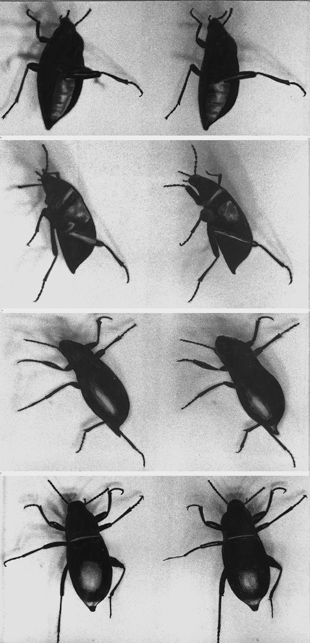
Diagonal somersault in Blaps halophila. Selected
stereoframes [reference 2].
We used photography with high-rate stroboscopic
illumination for
recording of swift events instead of filming.

Jump of the click beetle, Lacon murinus, at the
height almost 20 cm.
Collage of several stroboscopic recordings, flashing rate 100 Hz.
The beetle had white spots painted on the elytra and abdomen.
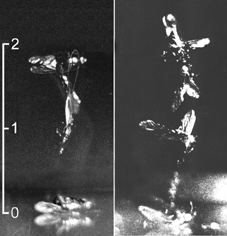
Jumps of the histerid beetle, Atholus duodecimstriatus.
Stroboscopic recordings, flashing rate 30 Hz [reference 3].
Somersault in a rose-chafer, Cetonia aurata on the
glass.
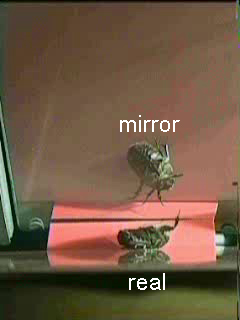
Another metod of 3D filming is filming with a mirror, inclined
by 45°. A videocamera is tilted by 90°, thus the real position of the
insect and its mirror image is in a Portrait format.
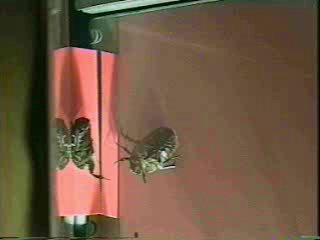
(video)
(All videos are in AVI format. Left-click on an
image to view in a separate window
or right-click and choose "Save File" to download)

Modes of righting in beetles: A - Dorcadion fulvum, B
- Cassida nebulosa, C - Emus hirtus, D-F - Epicometis hirta,
G,H - Byctiscus betulae.
Points of grasp or rest are indicated by circles.
Symmetrical somersault in a bug.
Bugs often behave like beetles when righting.
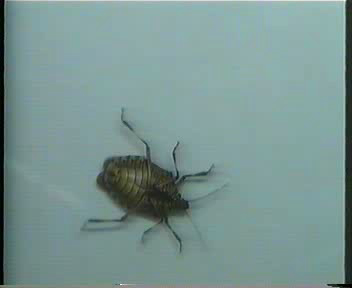
Symmetrical somersault in a pentatomid bug, Erthesina fullo.
(video)

Diagonal somersault in Erthesina fullo (video)
Diagrams of righting modes

A, B - righting by symmetrical grasp, C - righting
by symmetrical somersault,
D - righting using turn of the prothorax.
Center of mass is marked by an asterisk, fixed grasping points - by the filled
circles, slipping ground points - by blank circles.
References:
[1] Frantsevich L.I., Shumakova I.D., Mokrushov
P.A. 1984. Stereocinegrammetric analysis of insect movements (in Russian). Zhurnal
Obschey Biologii 45: 89-97.
[2] Frantsevich L.I., Shumakova I.D. 1983. Kinematics
of righting in Coleoptera. 3. Kinematics of the diagonal somersault (in Russian).
Vestnik Zoologii (Kiev) N 2: 8-12.
[3] Frantsevich L.I. 1981. The jump of the black
beetle (Coleoptera, Histeridae). Zool. Jb. Anat. 106: 333-348.
|



